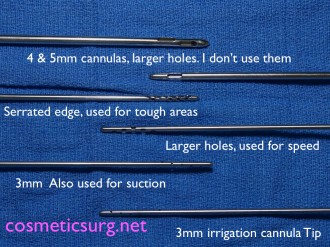
I perform all of my Liposuction procedures using the tumescent technique. The tumescent fluid acts to numb the area. After the area is numbed, the fat is removed with an instrument called a cannula. The cannula size plays an important role in the final surgical result! Small thin cannulas give smooth even results.
Tumescent Liposuction
There are many types of liposuction techniques, but I only perform tumescent Liposuction because it has a great track record. It is the gold standard for Liposuction. From small finesse areas to multiple area Liposuction it beats Smart lipo, Vaser, and Lipodissolve – hands down, no questions.
The term ‘tumescent’ refers to the fluid used to numb the area. It is injected into the area before the extraction of the fat begins. This fluid solution makes it easier to remove the fat with a cannula. The tumescent solution acts to numb the area and reduces the amount of blood loss during the procedure. The goal is to have the least amount of blood loss during the Liposuction procedure, so the function of the tumescent solution is very important to safety.
For the extraction of the fat, it is the cannula which removes the fat.
Other Liposuction techniques
Vaser, Smart lipo, and Lipodissolve all are having growing pains related to figuring out the best range for their respective modalities. Lipodissolve is what I would call a beta technology. Smart Lipo is 1st generation technology. Vaser is 2nd generation technology, but for some reason it’s not catching on. Tumescent Liposuction, however, is mature technology, and better yet, still innovating.
Liposuction cannulas
Cannula choice plays an important role in Tumescent Liposuction. The cannula is the instrument that the surgeon uses as his tool to extract the fat. Fortunately, there have been many refinements of cannula design. For example, a few years ago the standard for body contouring was using larger cannulas (4 and 5 mm) for the deep layers , and 3mm cannulas for the superficial layers. Nowadays I use exclusively 3 mm cannulas. Why? The result is much smoother. There is less bruising, less pain.
Let’s examine the different size cannula choices
If you look at the upper two cannulas in the photo above (4mm and 5mm cannulas), they have large holes. They make the fat extraction easy and fast, but at a price. When a surgeon uses these large cannulas there is more bruising, pain, and lumpiness. The surgical result is not as good.
The cannula at the bottom of this photo is narrower, and has a few very small holes. It was designed for putting fluid into the tissues, not suctioning fat. But it can be used for suctioning fat. It’s great because it can get really close to the skin without creating irregularities. I love it for finesse work. Using the small cannula takes more surgical time, but the results make it worthwhile.
The other 3mm cannula shown in the photo (near the bottom of photo) has larger holes and a higher number of holes. It is used for more aggressive, faster Liposuction. Because the holes are on one half of the cannula, by turning the holes away from the skin, it can be used very superficially.
The serrated cannula is used for tough fibrous areas such as the upper back. Years ago I used ultrasound lipo for these tough areas, but the serrated tumescent cannula gives me better control, and I can work really close to the skin, which is not a great option with Vaser or Smart lipo.
And that’s it! I can do the full range of lipo with just a few cannulas efficiently, with finesse, little bruising, and very little pain. Since I didn’t spend tens of thousands of dollars to buy rapidly outdated lipo machinery I can pass on the savings to you. More importantly, I can rest easy knowing you will have a great Liposuction result. I can’t even remember the last time any of my Liposuction patients needed a touch up. The tumescent method of Liposuction with thin cannulas gets it right the first time.



